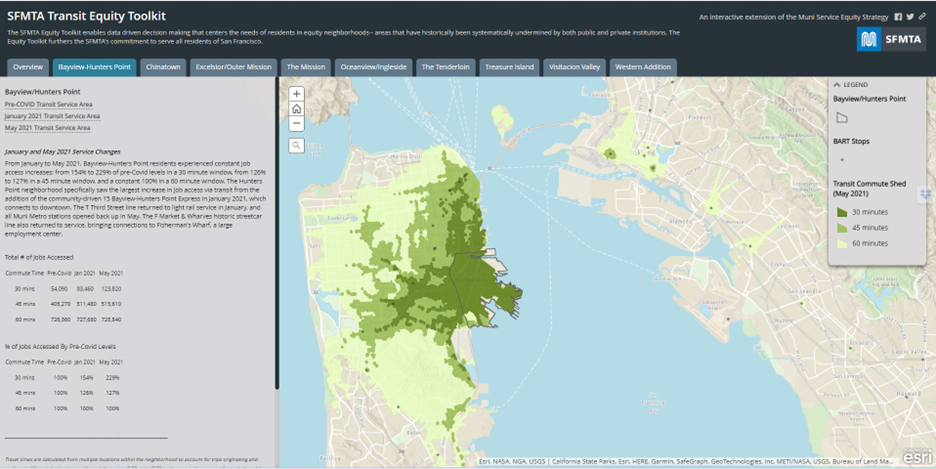
- October 3, 2023
- Transportation
Few obstacles create as obvious a barrier to economic mobility as lack of access to a job. In urban areas, that lack of access tends to be geographically concentrated in communities of color. One of the first cities to formally recognize this problem was San Francisco when, in 2014, the board of its Municipal Transportation Agency (SFMTA) adopted the city’s Muni Service Equity Policy. The policy’s goal is to correct transportation disparities and to make transit accessible and affordable for all the Agency’s customers.
San Francisco’s approach received powerful support when, just days after he took office, President Biden signed Executive Order 14008 inaugurating a whole of government initiative to tackle the climate crisis and its adverse impacts. As place so profoundly affects how residents experience adversity and opportunity, the order establishes the following goal known as Justice40, “that 40 percent of the overall benefits of certain Federal investments flow to ‘disadvantaged’ communities that are marginalized, underserved, and burdened by pollution.”
The U.S. Department of Transportation (USDOT) is key among the many agencies charged with implementing Justice40. For USDOT, implementation includes policies that promote utilization of public transportation and low emission vehicles and investments that “address gaps in transportation infrastructure” and “connect Americans to good paying jobs, fight climate change, and improve access to resources.” Although the design and execution of equity-enhancing strategies to increase job accessibility--especially in communities where car ownership is low--falls to regional and local transportation agencies, Executive Order 14008 helps USDOT evaluate transportation related projects using an equity lens.
Understanding where and how communities experience transportation disadvantage helps metropolitan planning organizations, state departments of transportation and local authorities design and select projects to mitigate those disadvantages. To support applicants for Justice40 funding, USDOT developed the Equitable Transportation Community (ETC) Explorer. The ETC Explorer is an interactive web application that layers data onto census tracts in the following areas: Transportation Insecurity, Climate and Disaster Risk Burden, Environmental Burden, Health Vulnerability and Social Vulnerability.

USDOT ETC Explorer Disadvantage Component Scores, San Fransisco County, California
Of note for this discussion is the ETC Explorer’s transportation insecurity index. The index includes inputs such as car ownership, commute times and jobs within a 45-minute drive. These variables are essential to understand, as proximity to employment has been shown to materially affect economic outcomes. In a report published by Brookings, the authors observed that people are more likely to work if they live closer to jobs. They spend less time looking for jobs and consequently tend to experience shorter periods of joblessness. Research also suggests a negative relationship between access to transportation and the likelihood a household is on public assistance. Raj Chetty and Nathaniel Hendren from Harvard University found greater upward mobility in low-income communities with more significant access to jobs within a fifteen-minute commute. While proximity does not guarantee work, access to jobs is a necessary if not sufficient condition for economic mobility.
In 2019 about five percent of workers in the U.S. commuted using public transportation. That figure understates usage in transit heavy cities like San Francisco and obscures the extent to which low-income and Black workers, young adults and women rely on public transportation. Lack of access disproportionately harms these groups as well as the elderly and people with disabilities, thereby aggravating economic and racial disparities. Since reliance on public transit is so strongly linked to race and income, transportation departments play an important role in ensuring equitable access to employment. Little wonder then, that the SFMTA sees furthering “racial equity, social equity and mobility justice” as part of its mandate.
As noted earlier, SFMTA’s board formally adopted its Muni Service Equity Policy in 2014. To operationalize the policy, the board convened an Equity Working Group composed of community-based and governmental organizations. The result of the working group’s efforts is SFMTA’s Muni Service Equity Strategy. The initial strategy launched in 2016 designated seven (now nine) equity neighborhoods for special attention and transit service improvement.

The neighborhoods were selected by layering the following data onto maps of the Agency’s service area:
- The concentration of low-income neighborhoods.
- The concentration of residents who identify with a race other than white.
- Private vehicle ownership.
- The concentration of affordable and public housing developments.
- Municipal routes heavily used by persons of color and low-income transit users.
As routes utilized by seniors and people with disabilities are less tightly tied to geography than the criteria above, data from San Francisco’s contactless transit cards were used to assess the needs of these groups. The nine communities that make up SFMTA’s equity neighborhoods are prioritized in transit and routing decisions and in the Agency’s biennial capital and operating budgets.
In a major evolution of its equity strategy, San Fransisco began development of an Equity Toolkit in 2020. Ess (Steph) Nelson, the Agency’s lead GIS engineer, describes the motivation this way: “At the beginning of the pandemic, like cities everywhere we had to scale back service significantly. As we did so, we wanted to make sure that we prioritized the needs of transit-reliant essential workers.” Similarly, SFMTA prioritized the city’s equity neighborhoods for service reinstatement. The Agency relied on the Equity Toolkit to measure the effectiveness of both its pare-down and build-back strategies and to lay the groundwork for future decision-making.
Distinctive in its approach, the Agency focuses on access to jobs as a key determinant of equity. The toolkit uses spatial analytics to calculate the number of jobs in essential industries accessible from the centroid of each census tract (snapped to the nearest network segment) in each of the equity neighborhoods. This allows the Agency to evaluate the equity effect of route adjustments and to identify gaps in coverage that need to be addressed. It also sets a performance baseline.
The toolkit combines data from six regional agencies, SFMTA, BART, Sam Trans, AC Transit, Golden Gate Transit and Caltrain. Thirty-, forty-five- and sixty-minute commute sheds are calculated by running network analyses that combine multi-modal transit and walking data by time of day every minute for thirty, forty-five and sixty minutes and taking a median value among each of the model runs. Using job counts from the U.S. Census Longitudinal Employer-Household Dynamics program, the toolkit then layers the number of accessible jobs onto maps of the commute sheds.
In response to the pandemic, SFTMA made substantial service cuts. As the pandemic waned, the Agency prioritized the nine transit-reliant equity neighborhoods for service reinstatement. The toolkit allowed planners to evaluate the impact of the changes they made. As noted in the Agency’s annual report, “Over the course of the pandemic, equity neighborhoods performed better than more affluent areas in terms of access to jobs via transit. This was the result of deliberate SFMTA planning to ensure residents living in equity areas have consistent and improved access to jobs and other critical resources.”

Pre-Covid Job Access v. Jan and May 2021 Bayview/Hunters Point Neighborhood
“We run analyses of the changes we make and look at the results with the service planners,” said Nelson “Together we ask ourselves, ‘What happened? Were there any unexpected results? Do we need to recalibrate our thinking?” Sandra Padilla, transit planner for SFMTA, puts it this way, “While the equity toolkit provides data post-implementation, we make service changes at least three times per year. So, it also provides valuable feedback to inform subsequent changes.” The Agency plans to develop a version of the toolkit using only its transit data. This will allow planners to isolate the impact of SFMTA service changes separate and apart from those of its sister agencies.
SFMTA’s prioritization of equity neighborhoods, coupled with its utilization of spatial analytics to increase access to jobs, provides a tangible model for transit agencies nationwide. In alignment with Justice40, it recognizes the vital role of transportation departments--a role that includes addressing climate concerns and fostering economic mobility. SFMTA’s multifaceted efforts transcend transportation planning; they represent a meaningful commitment to equity.

 Kate Markin Coleman has thirty years of experience as a senior executive in the private and social sectors. Her current research, advising and speaking focuses on social sector impact, scaling, cross sector collaboration and workforce development. She directs IAS advising LLC, a strategic consultancy for social ventures. She is co-author of two recently published books, Growing Fairly; How to Build Opportunity and Equity in Workforce Development and Collaborative Cities: Mapping Solutions to Wicked Problems.
Kate Markin Coleman has thirty years of experience as a senior executive in the private and social sectors. Her current research, advising and speaking focuses on social sector impact, scaling, cross sector collaboration and workforce development. She directs IAS advising LLC, a strategic consultancy for social ventures. She is co-author of two recently published books, Growing Fairly; How to Build Opportunity and Equity in Workforce Development and Collaborative Cities: Mapping Solutions to Wicked Problems.

